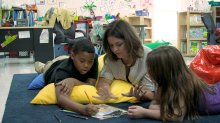An Inside Look at Trauma-Informed Practices
A Nashville elementary school takes a comprehensive approach to trauma-informed practices, creating a space where students feel known and supported.
Your content has been saved!
Go to My Saved Content.Schools across the U.S. are working in a variety of creative ways to meet the needs of students with trauma and tragedy in their backgrounds. Fall-Hamilton Elementary, in Nashville, does so by working to understand the adverse childhood experiences (ACEs) so many of the students bring with them to school—and the holistic impact that challenging life contexts have on a student’s academic performance.
ACEs are a pressing issue. According to a major study by the Centers for Disease Control and Prevention (CDC), more than 35 percent of children have experienced two or more ACEs, such as sexual or physical abuse or exposure to mental illness, drug or alcohol addiction, or the incarceration of a family member. In Nashville, 60 percent of children have experienced at least one ACE.
Fall-Hamilton has taken a whole-school approach to the issue, focusing on key relationships—between adults and students, among the staff, and among the students—and incorporating social and emotional learning comprehensively. The school also has a full-time trauma-informed practitioner on staff. These programs are designed to recognize and meet the social, emotional, and academic needs of students on a daily basis.
The result is a much improved school climate where students feel supported and known—and where academic performance is steadily rising.
Trauma-Informed Teaching: A Whole-School Approach
Fall-Hamilton is in the process of transitioning from what the principal, Mathew Portell, calls an “unsustainable” educational and professional environment to a place of support and safety in learning for both students and staff.
Emphasizing social and emotional learning and trauma-informed practices is a path to improving students’ academic outcomes. Natalie Vadas, a special education teacher, says that when students “know they can trust you and they talk to you, their academics start to blossom.” This was borne out in 2016, when Fall-Hamilton outperformed peer schools on the Achievement Network’s English language arts measures.
Encouraging Students’ Self-Regulation
For many children, recognizing and managing turbulent emotions in times of stress and conflict is a challenge. And for children with ACEs, the research suggests it’s even more difficult, since early trauma and repeated stress may overwhelm their fight-or-flight response, leading them to respond inappropriately.
To support students as they navigate everyday conflict, Fall-Hamilton has a nook called a peace corner in every room, with a comfortable seat, a timer—students generally need only a couple of minutes to calm down and reflect—and some distractions, like stuffed animals, or a prepared form on which students can explicitly document and monitor their own feelings and reactions.
A teacher may ask a student to take a break, but students can and will use the peace corners on their own. “If I get, like, really frustrated and feel like I’m gonna yell,” says Abby, a fourth grader, “I go to the peace corner and just calm down.” As Portell points out, the peace corners are a place where students are explicitly encouraged to use the strategies that the school is teaching across the curriculum.
It’s an idea other schools are trying as well, because the ability to regulate emotions is a key social and emotional skill, and students need specific guidance to develop it.
Building Mentor-Mentee Relationships
Fall-Hamilton identifies students who need a little extra attention and support—“on an educational level, but more of a social and emotional level as well,” says Portell—and pairs each one with an adult on staff who is not the child’s teacher. The students meet with their mentors for two minutes at the beginning and end of every day.
As Portell says, these students know “every day they come in this building that somebody’s excited to see them,” and feelings of safety and attachment to even one adult at school can improve a child’s ability to cope with adversity.
Supporting Teachers
In his initial work on social and emotional learning at Fall-Hamilton, Portell focused on the students. That’s natural enough, but teachers who work with students with ACEs also need help sometimes. “I didn’t support teachers in the way that I should’ve, and could’ve, because I was a new principal and I just didn’t know how,” he says.
One way the school has worked to provide that necessary support is through a system called “tap-in/tap-out,” which allows teachers to call on a peer when they need to take a break for a minute or two—that need to step back from a tense situation is not limited to children. “At the end of the day, you know that these kids rely on you, so we also need to take care of ourselves,” says teacher Natalie Vadas.
Fall Hamilton Elementary
Enrollment
312 | Public, UrbanPer Pupil Expenditures
$11725Free / Reduced Lunch
89%DEMOGRAPHICS:
This story was produced by Edutopia as part of a series developed in collaboration with the National Commission on Social, Emotional, and Academic Development, with support from the Chan Zuckerberg Initiative.
